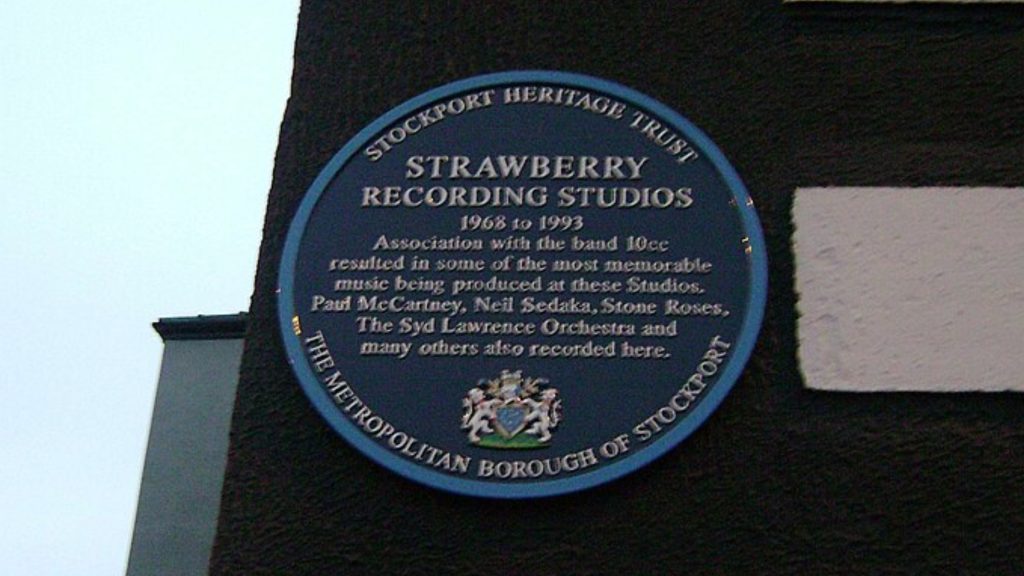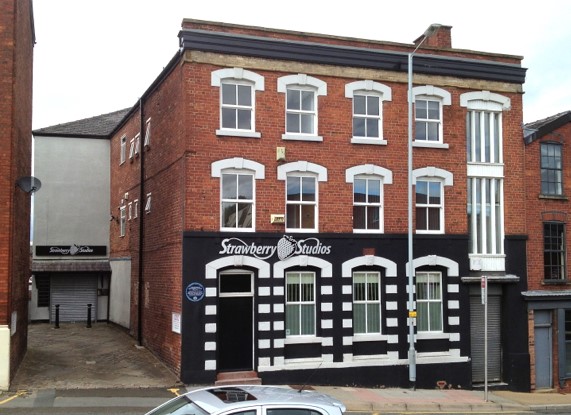Nestled in the heart of Stockport, a town buzzing with tales of musical legends and echoes of melodies past, Strawberry Recording Studios stands as a beacon of historical significance. Celebrating its fiftieth anniversary, this iconic studio has not only carved its name into the local lore but has also stamped its influence on the global music scene. Imagine, if you will, a place where every chord strummed and every note sung weaves into the fabric of music history, a place that has seen the birth of countless records flipped over in eager hands on the bus ride home, just to see that magical name in the small print.
For many, Strawberry Studios isn’t just a building; it’s a vault of memories, a cornerstone of their musical upbringing. As the first major professional recording studio outside London, its walls have absorbed the sounds of generations, becoming a silent witness to the evolution of music. The anticipation of discovering that a beloved record was born within its walls still thrills, a testament to its enduring legacy.
As we peel back the layers of Strawberry Studios’ storied past, we’re not just revisiting history; we’re stepping into a world where music and memory intertwine. Join us as we explore the echoes of Strawberry Studios, a place where every note tells a story, every beat marks a moment, and every song captures a piece of our collective soul.

The Origins of Strawberry Studios Stockport
Formation and Early Years
Ever wondered where some of the most iconic tracks in music history were born? Let’s dial back to Stockport in the late 1960s, a time when everywhere you looked, music was changing the world. Amidst this revolution, Strawberry Studios Stockport was conceived, not just as another recording space but as a hub where creativity knew no bounds. Founded by Peter Tattersall and Eric Stewart, Strawberry Studios began its journey above the Nield and Hardy record store, in Stockport town centre, in 1967. This wasn’t just another studio opening its doors; it was the start of a legacy that would go on to shape a significant part of music history.
Imagine the scene: cramped spaces, equipment barely fitting in rooms, and musicians bustling around, eager to lay down tracks. It’s here, amid the buzzing environment, that the studio’s name was inspired by Stewart’s favourite Beatles song, “Strawberry Fields Forever”, instilling a sense of musical reverence from the get-go. Their original makeshift recording setup, believed to include egg boxes used for sound insulation, might not have been state-of-the-art, but it had charm, and more importantly, it had potential. The move to Waterloo Road marked the beginning of serious business. With further investment from Graham Gouldman, the studio transformed into a professional setup, pulling in artists and bands, each leaving with tracks that would soon become a part of music collections worldwide.
The Shift to 10cc’s Home Studio
Why should music aficionados and casual listeners alike care about this shift? Well, this is the part where Strawberry Studios becomes more than just a recording space; it becomes a legend. Eric Stewart, Graham Gouldman, Lol Creme, and Kevin Godley, names which might sound familiar owing to a little band called 10cc, joined forces within these very walls. The studio became the crucible for their creativity, culminating in timeless hits such as “I’m Not in Love” and “Neanderthal Man”. It’s fascinating to think about how a space, initially intended for various recording endeavours, became the heartbeat of 10cc’s music-making process.
Their journey, from crafting bubblegum songs to producing the groundbreaking album “Sheet Music”, and beyond, posed the question: what makes a studio great? Is it the state-of-the-art stereo equipment or the creative minds that walk through its doors? Strawberry Studios, with its humble beginnings, including the innovative use of egg boxes for sound insulation and a control desk that became the command centre for countless recordings, proved that it’s the latter. It was their home, a place where experimentation wasn’t just welcomed; it was encouraged.
The Evolution of the Strawberry Studio
Expansion and Diversification
Strawberry Studios in Stockport. Now, there’s a name that evokes images of musical legends striding through its doors, from Joy Division to the Moody Blues, crafting songs that would echo across generations. But how did this Northern powerhouse evolve from its humble beginnings? How did it transcend its initial setup to become the cradle of such musical innovation?
In the early days, Strawberry Studios was, frankly, making it up as they went along. Sound insulation? Egg boxes on the walls were the go-to solution. Control desk? Anything that could manage the job was pressed into service. They recorded everything from the haunting melodies of Joy Division to the bubblegum songs of Hotlegs, proving that innovation isn’t about having top-of-the-line equipment but something far more vital: creativity and vision.
But the studio didn’t stay in these humble beginnings. Led by the vision of its founders and stewards, including the legendary 10cc, Strawberry Studios embarked on a journey of expansion and diversification. They recognised early on that to sustain and grow, they needed to offer more, to be more.
Enter Strawberry Studios South. This wasn’t just a geographical expansion; it was a statement of intent. Strawberry Studios was not content with being a Northern gem; it sought a national presence. It opened its doors to a wider array of artists, from Cliff Richard and Neil Sedaka to Paul McCartney, showcasing its versatility and pulling in talents from various musical genres.
Strawberry Studios South and Mastering Services
Strawberry Studios South marked a significant leap forward in the studio’s capabilities, equipped with more advanced technology and offering a broader range of services, including mastering. That’s right, mastering services that took recordings and polished them into the finished jewels we’d hear on the radio or play on our stereo equipment.
So, why should anyone care about this angle of the studio’s evolution? Well, it’s about more than just a studio expanding its premises and equipment. It’s a testament to the studio’s ethos of innovation, of pushing boundaries and embracing change. Strawberry Studios didn’t just adapt to the times; it helped shape them, setting trends that would ripple through the music industry.
The establishment of Strawberry Mastering was a natural progression in this journey. For a studio that had already done so much to shape the sound of an era, mastering was the final piece of the puzzle, allowing them to shepherd a song from initial recording all the way through to the final product. This wasn’t just about control; it was about ensuring the artist’s vision came to life in the most vivid possible sound.
Transitioning from a local endeavour to a player on the national stage, Strawberry Studios showed that evolution in the music industry isn’t just about keeping up. It’s about dreaming bigger, pushing further, and, most importantly, remembering that at the heart of every technological advancement, every expansion, is the music.

Iconic Recordings and Artists at Strawberry Studios
The Era of Joy Division and The Smiths
Why should anyone care about a bunch of recording sessions from decades ago? It’s simple, really. It’s about the sounds that defined generations and the walls that witnessed the birth of iconic tracks. At Strawberry Studios in Stockport, something extraordinary was happening. This wasn’t just another studio. It became a crucible for transformation within the British music scene, particularly during the era of Joy Division and The Smiths.
Imagine stepping into Strawberry Studios during this period. You’d find yourself in the midst of a musical revolution. Joy Division’s groundbreaking album “Unknown Pleasures,” produced by the legendary Martin Hannett, was more than just an album. It was a declaration, a completely new sound that rippled through the music industry. The dense, atmospheric production pushed the boundaries of what music could be. But why did it matter? Because it showed musicians everywhere that limitations only exist in the mind.
Following in these influential footsteps, The Smiths recorded parts of their music at Strawberry, laying down tracks that would become anthems for the disenchanted. Morrissey’s unique voice and Marr’s jangling guitar found a perfect setting among the studio’s innovative sound insulation techniques, yes, even those famed egg boxes. It was here that The Smiths’ music gained the polished yet profoundly emotive sound that fans adore.
Strawberry Studios Collaborations with Sir Paul McCartney and Others
But it wasn’t just about the raw edge of post-punk and indie; Strawberry Studios also played host to a variety of genres, including the legendary Paul McCartney. Sir Paul’s visit to Strawberry Studios wasn’t just a footnote in its history—it was a testament to its versatility and quality. Working in a space that had seen the likes of Joy Division and the moody brilliance of The Smiths, McCartney’s presence underscored Strawberry’s status as a top-tier studio. He found a creative haven amidst its walls, contributing to music that ranged from rock to classical. McCartney’s presence there begs the question: what makes a studio great? Is it the gear, the acoustics, the people? Or perhaps it’s the history, the stories soaked into the walls, that inspire greatness.
Collaborations in Strawberry Studios weren’t limited to McCartney. The space saw visits from Cliff Richard, Neil Sedaka, and the Moody Blues, among others. These sessions blended talents across the spectrum, from bubblegum songs to profound ballads, showcasing Strawberry’s adaptability. Each artist left a mark, a sonic signature that contributed to the rich tapestry of sounds associated with Strawberry.
Strawberry Studios was more than just a set of rooms with stereo equipment; it was a place where artists felt empowered to experiment, to push their artistic boundaries. The collaborations and recordings that took place there were not just about creating hit records; they were about capturing moments of pure creative synergy.
Cultural Impact and Legacy
The Strawberry Studios Walk
Why should anyone care about a simple studio in Stockport, you might ask? Well, imagine taking a stroll where the echoes of the past still resonate with the sound of music that changed the world. The Strawberry Studios Walk isn’t just a path you tread; it’s a journey through time where every step brings you closer to legends. Names like Joy Division, The Smiths, and 10cc aren’t just inscribed on albums; they’re etched into the very pavements of Stockport, thanks to Strawberry Studios.
Consider this: without Strawberry Studios, the haunting melodies of Joy Division’s “Unknown Pleasures” might never have reverberated beyond the walls of a lesser studio. Or perhaps 10cc’s innovative hit “I’m Not in Love” would have lingered as a mere concept, never reaching the ears of eager listeners worldwide. The Strawberry Studios Walk offers more than a march through Manchester’s musical history; it provides a tangible connection to these monumental moments. It’s not just about seeing where the magic happened; it’s about feeling it in the soles of your feet, the air around you, even the pulse in your veins. Is there a better way to understand the cultural tsunami that stemmed from a humble studio in Stockport?
Strawberry Studios Influence on the Manchester Music Scene
Strawberry Studios did not just influence the music scene; it redefined it. Before the era of digital downloads and streaming, studios were the sacred sites where music was born, and Strawberry was the cradle of Manchester’s sonic revolution. Picture a place where Paul McCartney could brush shoulders with the Moody Blues, where Neil Sedaka could share a nod with Cliff Richard, all amidst the backdrop of revolutionary sound equipment and, yes, even egg boxes for sound insulation. It’s this eclectic mix that brewed the unique Strawberry sound.
But why does this matter today? Because the ethos of Strawberry Studios – experimentation, creativity, and collaboration – permeates the Manchester music scene even now. Bands like the Stone Roses and the Smiths didn’t just happen. They were the fruits of a culture that Strawberry Studios nurtured, a culture where boundaries were there to be pushed, and genres were mixed as freely as the drinks in a post-recording session. This legacy acts as a beacon for new artists, inviting them to innovate, collaborate, and contribute to the evolving tapestry of Manchester music.
The Closure of Strawberry Studios
Reasons Behind the Sale and Closure
Ever pondered why some legendary music spots, ones steeped in history like Strawberry Studios in Stockport, close their doors for good? It’s not merely a tale of financial transactions; it’s more akin to the end of an era, where memories cling to the walls and every sound vibration tells a story. So, why should anyone care about the closure of such an iconic studio, you may ask? Well, let’s delve into that.
The closure of Strawberry Studios in 1993 wasn’t just the shutting down of a building; it marked the culmination of a storied chapter in Manchester’s illustrious music scene. For a place that had seen the likes of Paul McCartney, Joy Division, and The Smiths grace its recording booths, the decision to close wasn’t taken lightly.
Several factors led to the sale and eventual closure of Strawberry Studios. Among them, evolving music production technology stands out. By the early ’90s, the music industry was rapidly changing. The advent of digital recording and home studios diminished the need for traditional, large-scale recording spaces. Strawberry Studios, renowned for its state-of-the-art facilities in the ’70s and ’80s, found its equipment becoming outdated.
Moreover, the studio’s legacy as a space for innovation and legendary recordings couldn’t shield it from the economic realities of maintaining such a premises. Costs for sound insulation, maintaining the control desk, and updating stereo equipment became prohibitive.
While it’s easy to point to financial and technological reasons for the studio’s closure, there’s an emotional angle too. The very soul of the studio, its ability to serve as a crucible for musical creativity, began to wane. The industry’s shift towards digital meant that the intimate, collaborative nature of music production that Strawberry Studios epitomised was becoming a thing of the past.
In reflecting on why the closure of Strawberry Studios matters, it’s about understanding the end of a tangible piece of Manchester’s musical heritage. The essence of countless musicians’ breakthrough moments, from the dreamy melodies of The Moody Blues to the groundbreaking punk of Joy Division, was encapsulated within those walls. It’s a reminder of how locations can become synonymous with cultural movements, influencing and shaping them in ways that resonate beyond their physical boundaries.

Reflections on Strawberry Studios
Personal Anecdotes and Testimonials
Exploring the labyrinthine history of Strawberry Studios in Stockport, one cannot help but be drawn into the vibrant personal stories and glowing testimonials that paint a vivid picture of its impact. Why should these tales of creativity and innovation matter to us? They breathe life into the bricks and mortar, transforming the studio from a mere historical footnote into a living, breathing epicentre of music history that continues to resonate with artists and fans alike.
Imagine stepping into a studio that once buzzed with the creative genius of bands like 10cc and Joy Division or hosted legendary sessions with Paul McCartney. The walls of Strawberry Studios, if they could talk, would narrate stories of groundbreaking recordings — from the experimental sounds of “Neanderthal Man” by Hotlegs to the haunting melodies of Joy Division. These anecdotes serve as a bridge, offering us a personal connection to the studio’s illustrious past. They challenge the norm, prompting us to ponder, “What makes a place truly remarkable? Is it the equipment, like the iconic control desk or the improvised sound insulation made from egg boxes, or is it something more intangible?”
The testimonials of those who recorded there, from the stars like Neil Sedaka and Cliff Richard to local heroes like The Smiths and Stone Roses, add layers of depth to our understanding of Strawberry Studios. For instance, hearing about how the Moody Blues found solace within its walls, or how Barclay James Harvest crafted their lush soundscapes in this northern haven, adds a rich texture to the studio’s legacy. These stories aren’t just footnotes in music history; they are testaments to the studio’s role as a crucible of creativity.
Moreover, the studio’s evolution, from its humble beginnings above a record store to becoming a beacon of musical innovation with both Strawberry Studios North and South, underscores the transformative power of vision and perseverance in the music industry. The personal anecdotes of those who walked through its doors encapsulate not only their artistic journeys but also the studio’s unique ability to adapt and thrive amidst the changing tides of musical tastes.
Conclusion
Strawberry Studios not only marked an era of musical innovation in Stockport but also left an indelible mark on the world’s music scene. From its humble beginnings to becoming a sanctuary for artists like Paul McCartney and Joy Division, the studio’s legacy is a testament to the transformative power of creativity. Despite its closure, the stories and albums born within its walls continue to inspire musicians and music lovers alike. It’s a reminder of how places steeped in history can shape cultural movements and foster a community of artists who push the boundaries of their craft. Strawberry Studios might have closed its doors, but its influence on music and the memories it created will forever resonate with those who were part of its journey.
Stephen F is the publisher of this website, he is a long term resident of Stockport. Over the years he has explored every area within Stockport from the Merseyway Shopping Centre to the Etherow Country Park trails.
He can often be found on a lazy Saturday morning frequenting one of Stockport's many coffee shops sipping his favourite latte.
One of his big passions is to go for long country walks with his pet golden retriever Lottie.
One thing is certain he knows Stockport!

